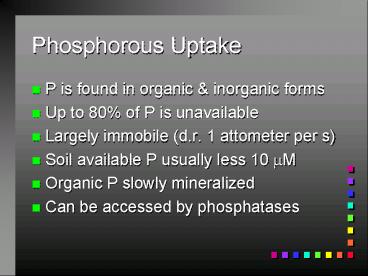Phosphorous Uptake - PowerPoint PPT Presentation
1 / 20
Title:
Phosphorous Uptake
Description:
Phosphorous Uptake. P is found in organic & inorganic forms. Up to 80% of P is unavailable ... Hyphae penetrate cortical cells, but no arbuscle formed ... – PowerPoint PPT presentation
Number of Views:341
Avg rating:3.0/5.0
Title: Phosphorous Uptake
1
Phosphorous Uptake
- P is found in organic inorganic forms
- Up to 80 of P is unavailable
- Largely immobile (d.r. 1 attometer per s)
- Soil available P usually less 10 mM
- Organic P slowly mineralized
- Can be accessed by phosphatases
2
pH and P availability
3
Roots Mycorrhizae
- Plants maximize absorption area
- Root hair and root caps secrete mucilage
- Creates hydration sheath contains
polysaccharides - Fungus food
4
Mycorrhizae
- Myco fungi rhizae root
- Mutualistic symbiotic relationship between fungus
and plant - Ancient association
- In nature 90 of plants infected with MR
- 83 DICOTS
- 79 MONOCOTS
- 100 GYMNOSPERMS
5
Mycorrhizae
- Only a few plant families (3) do not form
associations with MR - Some plants have an absolute reproductive
requirement for MR association - MR are classified as ectoMR or endoMR or
intermediate MR 3 others
6
Mycorrhizae
- Increase water uptake in plant
- Increase mineral uptake especially P, Cu Zn
- How?
- Improve soil texture
7
Mycorrhizae
- Nutrient exchange occurs in the intercellular
spaces or cells - Up to 20 of plant carbon is allocated to
mycorrhizae - Mycorrhizae extend root area
- Mycorrhizae can penetrate smaller crevices than
root hairs
8
Mycorrhizae
- Fungal mycelium metabolically less expense to
maintain for the plant than extended root system - Mycelium can sequester heavy metals (Os, Pb)
- Mycelium limits uptake of Al, As, Ti. Ba Cd)
9
Mycorrhizae
- Offers additional biochemical pathways to plant
- MR are reported to improve abiotic and abiotic
stress tolerance - antibiotic production
- MR may form plant to plant network
- Allows for nurturing of seedlings in understories
where light is limiting
10
Ectomycorrhizae
- EctoMR are members of the basidomycetes or the
ascomycetes - Infect Pinaceae, Fabaceae, and temperature
forests - Form a sheath around the root
- The mass of the hyphae mass of roots
11
Ectomycorrhizae
- Hyphae grow between the spaces in the cortical
root cell - Forms a network called Hartig net
- No cellular penetration by the hyphae
- Reproductive spores are formed in the soil only
12
Endomycorrhizae
- Belong mainly to Glomalae family
- Were called VAM (vesicular arbuscular
mycorrhizae) - Infect grasses, most herbaceous dicots, many
perennial shrubs and 6 genera of gymnosperms
13
Endomycorrhizae
- Dont form a Hartig net
- Hyphae grow into intercellular spaces of cortical
cells, but penetrate cell walls - Direct cell to cell exchange of nutrients
- Hyphae form arbuscles (Bulb structure) where they
penetrate plant cell - Spores can form inside or outside of plant cell
14
Other Mycorrhizae
- Ectendomycorrhizae (Ericaceous MR)
- Intermediate in habit
- Hyphae penetrate cortical cells, but no arbuscle
formed - Infect Ericaceous plants - largely woody shrubs
(i.e. bearberry, rhododendron, labrador tea
plant)
15
Other Mycorrhizae
- Orchidae Mycorrhizae
- Only infect orchids
- Orchids cannot grow without infection
- Endomycorrhizae but no arbuscles
- Many achlorophyllous orchids parasitize their MR
16
Mycorrhizae and Agriculture
- Many agricultural practices are detrimental to MR
development - Tillage destroys network
- Summerfallow and/or chemfallow destroys MR hosts
- Canola in field decreases MR populations
17
Mycorrhizae and Agriculture
- MR show some host specificity, therefore crop
rotations impact on MR populations - Excess P availability results in plants not
allowing the association - decreases MR
population - Therefore certain fertilizer regimes can be
counter productive
18
Mycorrhizae and Agriculture
- Many inoculants available
- Forestry and citrus orchards
- Problems
- mycelium better inoculant in many cases
- difficult to grow in culture
- species specificity reduces effective range
19
Other Microbial Agents
- Pseudomonas sp Bacillus megaterium
- PGPBs Or PSBs
- Work through 1 of 2 mechanisms
- Phytohormones secretion improve root growth
- Secretion of acid compound which solubilize
phosphate - Aspergillis sp.
20
JUMPSTART or PROVIDE
- Penicillium bilaii
- Solubilizing fungi?
- Registered as an inoculum for many crops
including canola - PHILOM BIOS LTD
- Also Aspergillis sp.































